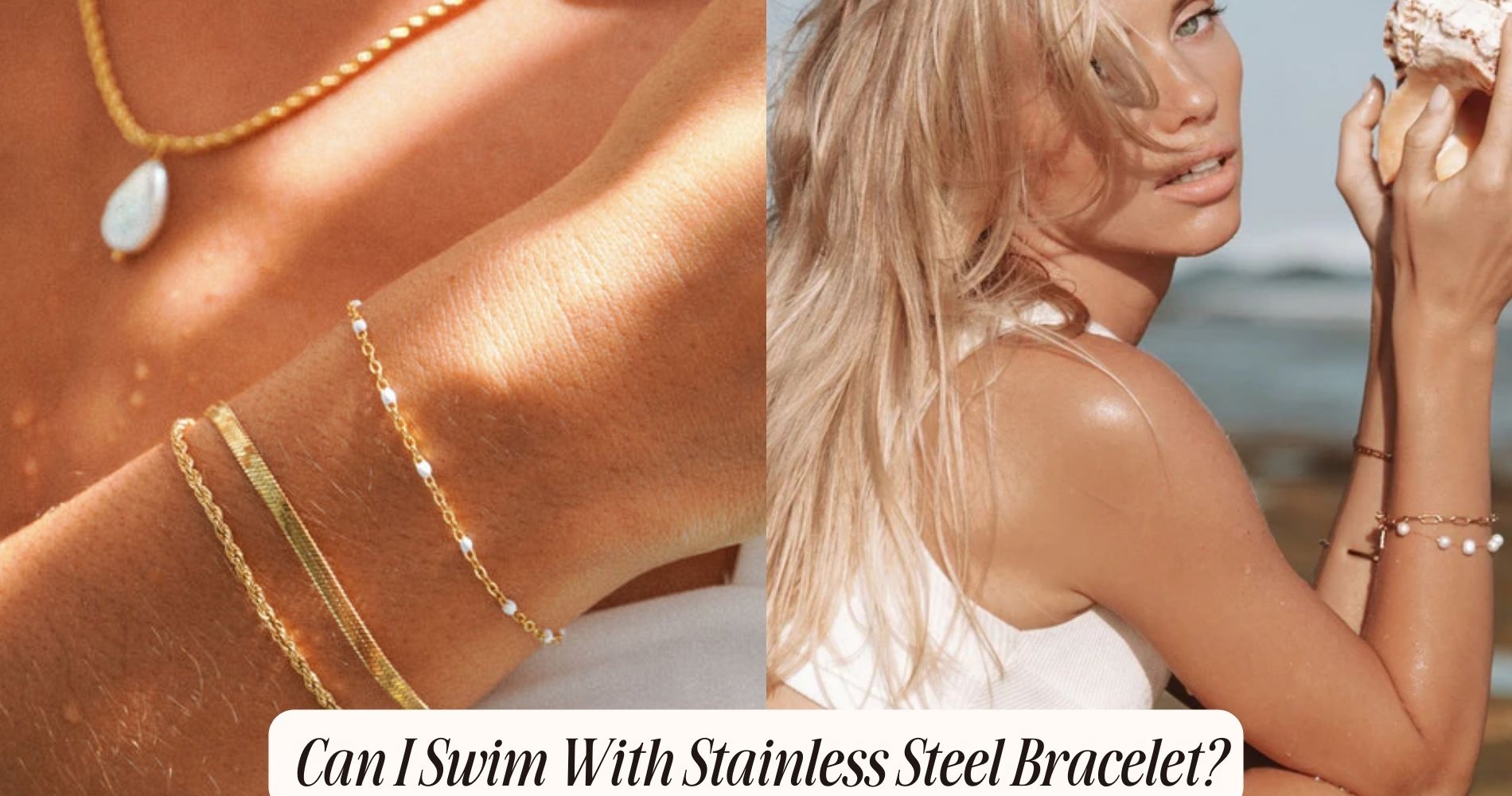
Can I Swim With Stainless Steel Bracelet?
When swimming with a stainless steel bracelet, it's crucial to maintain the impressive corrosion resistance that stainless steel offers. Stainless steel is a popular choice for jewelry due to its ability to withstand water exposure without rusting easily. This resistance to corrosion is attributed to the chromium content in stainless steel, which forms a thin, invisible oxide layer on the surface when exposed to oxygen. This oxide layer acts as a protective barrier, preventing water and oxygen from reaching the underlying metal and causing rust.
To guarantee effective rust prevention, it's essential to preserve this oxide layer by regularly cleaning your stainless steel bracelet after swimming. Use a mild soap and water solution to remove any chlorine, salt, or other contaminants that may compromise the protective layer. Avoid abrasive cleaners or materials that could scratch the surface, as this can damage the oxide layer and reduce the bracelet's corrosion resistance over time.
Impact of Chlorine on Bracelet
Preserving the corrosion resistance of your stainless steel bracelet becomes paramount when considering the impact of chlorine exposure on its longevity and appearance. Chlorine exposure, commonly found in swimming pools, can have detrimental effects on your bracelet. When stainless steel comes into contact with chlorine, a chemical reaction can occur, leading to potential discoloration of the metal. The chlorine can react with the nickel in the stainless steel alloy, causing the bracelet to change color and lose its shine over time.
To mitigate the effects of chlorine exposure on your stainless steel bracelet, it's advisable to rinse the bracelet with clean water after swimming to remove any residual chlorine. Additionally, periodic cleaning with a mild soap and water solution can help maintain the bracelet's appearance. Avoid prolonged exposure to chlorinated water to prevent accelerated discoloration of your stainless steel bracelet. By taking these precautions, you can enjoy swimming with your stainless steel bracelet while preserving its luster and longevity.
Effects of Saltwater on Stainless Steel
Regular exposure to saltwater can impact the corrosion resistance of your stainless steel bracelet, potentially leading to changes in its appearance over time. Stainless steel is known for its rust prevention properties; however, when exposed to saltwater, it can still be vulnerable to corrosion. The salt in the water can act as an electrolyte, accelerating the corrosion process on the metal surface. This can result in the formation of rust-like spots or tarnishing on your bracelet.
Saltwater effects on stainless steel are primarily due to the chloride ions present, which can break down the protective layer of chromium oxide on the steel's surface. This breakdown compromises the steel's ability to resist corrosion, making it more susceptible to rust formation. To minimize these effects, rinsing your bracelet with fresh water after swimming in the sea can help remove salt residue and prevent prolonged exposure to accelerate corrosion. Additionally, drying your bracelet thoroughly post-rinse can further aid in rust prevention.
Maintenance Tips for Swimming
When swimming with a stainless steel bracelet, remember to care for it properly in water by avoiding harsh chemicals that can damage its shine.
Always rinse and dry the bracelet thoroughly after swimming to prevent any potential corrosion or discoloration.
These maintenance tips will help prolong the life of your stainless steel bracelet and keep it looking as good as new.
Bracelet Care in Water
To guarantee the longevity and luster of your stainless steel bracelet while swimming, implement these essential care tips.
Firstly, make sure your bracelet has proper waterproof protection, especially if it isn't specifically marketed as water-resistant. Look for seals or gaskets that can prevent water from seeping into the bracelet links.
Secondly, consider the bracelet material. Stainless steel is generally more resistant to corrosion compared to other metals, but it's still important to rinse your bracelet with fresh water after swimming in saltwater or chlorinated pools. Dry it thoroughly with a soft cloth to prevent water spots or residue buildup.
These simple practices will help maintain the quality of your stainless steel bracelet for years to come.
Avoid Harsh Chemicals
For optimal maintenance of your stainless steel bracelet while swimming, be mindful to steer clear of harsh chemicals that can tarnish its shine and durability. Water exposure can lead to metal reactions that might impact the appearance and quality of your bracelet. Chlorine, found in pools, is a common culprit that can cause discoloration and damage to stainless steel.
Avoid wearing your bracelet in hot tubs or while applying sunscreen, as these products often contain chemicals that are harmful to stainless steel. To safeguard your bracelet, it's recommended to remove it before coming into contact with any harsh substances.
Rinse and Dry Thoroughly
To maintain the quality and appearance of your stainless steel bracelet after swimming, make sure to thoroughly rinse and dry it to prevent potential damage from water exposure.
Water exposure can lead to tarnishing and corrosion, affecting the longevity of your bracelet. After swimming, gently rinse the bracelet with fresh water to remove any salt, chlorine, or other impurities that may have accumulated. Use a soft cloth to dry the bracelet completely, ensuring no moisture is left behind.
This simple step is essential in maintaining the integrity of your stainless steel bracelet. Proper metal care, like rinsing and drying thoroughly, can help extend the life of your bracelet and keep it looking its best for years to come.
Risks of Swimming With Bracelet
Swimming with a stainless steel bracelet poses potential risks due to the metal's conductivity and weight, which can impact your safety in the water. While stainless steel is known for its durability, prolonged water exposure can still have negative effects on the bracelet. The chlorine in swimming pools and the salt in seawater can corrode the metal over time, leading to tarnishing or discoloration.
Additionally, the weight of the bracelet can become a safety concern while swimming, especially if it gets caught on something underwater or hinders your movements. In the case of an emergency, the added weight of the bracelet might make it harder for you to stay afloat.
Moreover, the conductivity of stainless steel increases the risk of electrical hazards if you come into contact with an electrically charged object or equipment while swimming. This can pose a serious threat to your safety. Hence, it's advisable to remove your stainless steel bracelet before entering the water to prevent these potential risks.
Cleaning After Swimming
After swimming, it's important to clean your stainless steel bracelet thoroughly to maintain its shine and longevity. Chlorine and saltwater can cause tarnishing and corrosion if left on the bracelet. To clean it, start by rinsing the bracelet under lukewarm water to remove any traces of pool chemicals or salt. Gently wipe it with a soft cloth or a microfiber towel to dry it completely. Avoid using harsh chemicals or abrasive materials that could damage the stainless steel.
Remember to follow poolside etiquette by not wearing your bracelet into the pool to prevent unnecessary exposure to chemicals. If you want to wear accessories while swimming, opt for waterproof accessories specifically designed for water activities. Waterproof accessories are more resistant to damage caused by chlorine, saltwater, and other pool chemicals.
Conclusion and Final Thoughts
In maintaining the quality of your stainless steel bracelet, proper cleaning and care are essential for preserving its shine and longevity. Stainless steel bracelets are known for their durability and water resistance, making them suitable for everyday wear and activities like swimming. However, prolonged exposure to chlorine, saltwater, or harsh chemicals can still impact the bracelet's appearance and structural integrity over time.
To make sure your stainless steel bracelet stays in top condition, it's recommended to rinse it with fresh water after swimming to remove any residues that may cause corrosion. Additionally, periodic cleaning with a mild soap and soft cloth can help maintain its luster and prevent tarnishing. While stainless steel is resistant to rust, it isn't entirely impervious to damage, so proper care is essential for prolonging its lifespan.
Atolea Jewelry’s Waterproof Bracelets Collection
At Atolea Jewelry, we understand the need for durable, stylish, and swim-friendly accessories. Our Waterproof Bracelets collection is designed with the active individual in mind. Crafted from high-grade stainless steel and other waterproof materials, these bracelets are perfect for those who lead an active lifestyle and prefer not to remove their jewelry.
- Tarnish-Free and Made for Everyday Wear: Our waterproof bracelets are not only stylish but also built to last. They will not fade, tarnish, or lose their appeal, no matter how often you wear them in the water.
- Versatility and Style: Whether you’re looking for something subtle for daily wear or a statement piece for special occasions, our collection has something to suit every taste and need.
- Lifetime Wear: With Atolea Jewelry, you invest once and enjoy forever. Our bracelets are designed to be a permanent part of your life, accompanying you through every swim, shower, and adventure without the risk of damage.
Frequently Asked Questions
Can Swimming in Hot Tubs Damage a Stainless Steel Bracelet?
Swimming in hot tubs can affect a stainless steel bracelet due to chlorine exposure. It's crucial to take into account the chlorine effect on the metal. However, stainless steel is generally compatible with saltwater, providing more durability for your bracelet.
Will Sunscreen Affect the Longevity of a Stainless Steel Bracelet?
Applying sunscreen can potentially affect the longevity of a stainless steel bracelet. The chemicals in sunscreen may cause discoloration or tarnishing over time. To preserve your bracelet, consider cleaning it regularly and avoiding direct contact with sunscreen.
Is It Safe to Swim With a Stainless Steel Bracelet in Freshwater Lakes?
Swimming in freshwater lakes with a stainless steel bracelet is generally safe. Avoid prolonged exposure to water as it may cause rust. However, be cautious with ocean swimming as saltwater can accelerate tarnishing.
Can High Water Pressure Impact the Durability of the Bracelet?
Swimming in saltwater can impact the durability of stainless steel bracelets due to its corrosive nature. However, stainless steel is known for its corrosion resistance, making it a suitable choice for water activities.
How Does Exposure to Pool Chemicals Affect the Bracelet's Shine?
Exposure to pool chemicals, like chlorine, can affect the bracelet's shine. Chlorine reaction may cause discoloration and oxidation risk, diminishing the bracelet's appearance. Rinse the stainless steel bracelet thoroughly after swimming to maintain its luster.
Conclusion
To sum up, swimming with a stainless steel bracelet is generally safe, thanks to its corrosion resistance properties. However, exposure to chlorine and saltwater can still have negative effects on the bracelet over time.
To maintain the bracelet's appearance and durability, it's important to follow proper maintenance tips and clean it after swimming.
With the right care, you can enjoy swimming with your stainless steel bracelet without worrying about potential risks.
























Leave a comment
This site is protected by hCaptcha and the hCaptcha Privacy Policy and Terms of Service apply.